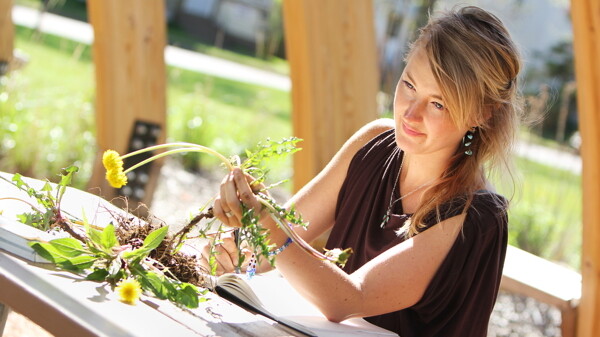Community Supported Art Takes Root
new Eau Claire Regional Art Center program links artists, buyers
Tom Giffey, photos by Andrea Paulseth |

at the Forest Street Community Garden. The sketches will be transformed into
prints which will be given to shareholders through the Eau Claire Regional Art
Center’s new community supported art program.
As the desire for wholesome, ethically raised, locally grown food has increased, so has the prominence of community supported agriculture. Members of CSAs pay in advance for periodic (usually weekly) boxfuls of vegetables, fruits, and other edibles during the growing season. The CSA model nourishes bellies and the local agricultural economy.
Now the CSA format is being imitated as a way of feeding our human need for beauty and creativity. Inspire by a successful program in Minnesota, the Eau Claire Regional Arts Center has launched a different kind of CSA: a community support art program. Original works by nine regional artists – including painters, photographers, a potter, and even a poet – will be available to the first 25 “shareholders” who buy into the CSA.
“We really want to connect our artists to patrons,” says Rose Dolan-Neill, who is coordinated the project for the arts center. “This is not a fundraiser for ECRAC at all. … It’s bringing the artists and patrons together and building lasting relationships, forwarding their careers here, and building up a supportive arts community.”
The immediate inspiration for the Eau Claire program is an art CSA, now in its fifth year, founded by Springboard for the Arts in St. Paul. The Springboard CSA has served as a muse for more than 50 similar programs coast to coast (including, beginning this year, one in Washburn).
"It’s bringing the artists and patrons together and building lasting relationships, forwarding their careers here, and building up a supportive arts community." – Rose Dolan-Neill, Eau Claire Regional Arts Center, on the new CSA (community supported art) program
In Eau Claire, shareholders will pay $250 each in exchange for nine pieces of art, delivered in three increments at special events over the course of the summer: June 26 during an opening reception at ECRAC’s Janet Carson Gallery; July 31 at the Volume One Sounds Like Summer Concert Series in Phoenix Park; and Sept. 20 at the Artist Market in Phoenix Park. And, in much the same way as farm CSA boxes often contain bonus zucchini or kale, the art CSA boxes will include “bumper crop” items such as tickets, T-shirts, and extra works of art, Dolan-Neill says.
While the artists involved won’t make a fortune – each will get a $500 stipend for the creation of 25 new works – participating in the CSA will still be a rewarding experience, Dolan-Neill says. In addition to getting paid upfront (a relatively rarity for artists), reaching 25 CSA shareholders creates “25 opportunities for making connections in the community and building their network,” she says.
A jury assembled by ECRAC selected the nine featured artists from among 22 applicants. The field is broad, including names that may be familiar and unfamiliar to followers of the Valley’s arts scene: painter Jodine Balow; potter Darrel Bowman; photographer Tom Gardner; photographer Hope Greene; linocut printmaker Kerri Kiernan; painter Patricia Mayhew-Hamm; sculptor Crysten Nesseth; painter Harlie Wensel; and poet Aryn Widule. Artists were selected both for their professional skill and for their ability to meet the challenge of creating 25 works of art during the necessary timeframe, Dolan-Neill says. Works offered will be roughly uniform in size (to avoid, for example, one shareholder getting a huge canvas while the rest get only tiny paintings), but they won’t necessarily be uniform in design. “Each piece is unique because it’s handmade,” she says.
While CSAs elsewhere – including the one in St. Paul – have as many as 50 shareholders, ECRAC decided to start smaller to gauge community interest. While the $250 price tag may seem steep for some Chippewa Valley art lovers, Dolan-Neill noted that shares can be split among a group of friends pitching in to cover the costs.
The similarity between community supported agriculture and community supported art served as inspiration for one of the contributing artists. When she was considering applying to be part of the CSA, Kiernan – a printmaker, herbalist, and gardener – began to ponder how food CSAs connect farmers with buyers. She decided to do something similar: She’ll create prints depicting five different plants – including stinging nettle, yarrow, and dandelion – that are often considered weeds but actually serve useful purposes. Along with the prints, Kiernan will give CSA shareholders handwritten instructions on how these plants can be used.
“It’s hard to sometimes find a motivation to start a new project and finish it,” Kiernan says. “I like having a deadline and just being able to involve my other interests and pursuits and talents into this.”
Want to buy a CSA share? Do it in person at the Eau Claire Regional Arts Center, 316 Eau Claire St.; by phone at 715-832-2787; or online at EauClaireArts.com (click on “Tickets” and then “Community Supported Art”).






















